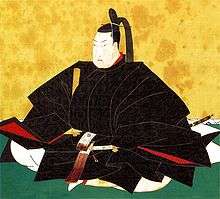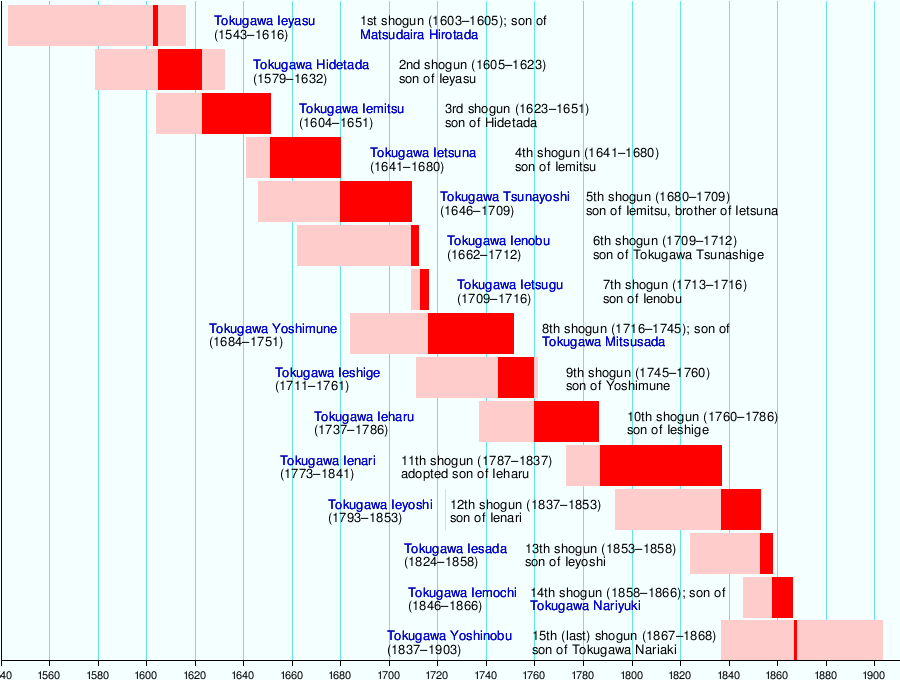Tokugawa Tsunayoshi
| Tokugawa Tsunayoshi | |
|---|---|
 Tokugawa Tsunayoshi | |
| 5th Edo Shogun | |
|
In office 1680–1709 | |
| Monarch |
Emperor Reigen Emperor Higashiyama |
| Preceded by |
Shogun: Tokugawa Ietsuna Lord of Tatebayashi: Matsudaira Norihisa |
| Succeeded by |
Shogun: Tokugawa Ienobu Lord of Tatebayashi: Tokugawa Tokumatsu |
| Personal details | |
| Born | 23 February 1646 |
| Died | 19 February 1709 (aged 62) |
| Children |
Tsuruhime (1677-1686) by oden Tokugawa Tokumatsu (1679-1686) by oden chosomaru (1683-1686) by yasuko Yanagisawa Yoshisato (1686-1724) by sumeko Adopted: Tokugawa Ienobu Kichihime Yaehime Matsuhime Takehime |
| Father |
Tokugawa Iemitsu (Father) Keishouin (Mother) |
Tokugawa Tsunayoshi (徳川 綱吉, February 23, 1646 – February 19, 1709) was the fifth shogun of the Tokugawa dynasty of Japan. He was the younger brother of Tokugawa Ietsuna, thus making him the son of Tokugawa Iemitsu, the grandson of Tokugawa Hidetada, and the great-grandson of Tokugawa Ieyasu.[1]
He is known for instituting animal protection laws, particularly for dogs. This earned him the nickname of "the dog shogun." He had a dog named takemaru.
Early years (1646–1680)
Tokugawa Tsunayoshi was born on February 23, 1646, in Edo. He was the son of Tokugawa Iemitsu by one of his concubines, named Oman, later known as Keishōin 桂昌院 (1627–1705). Tsunayoshi had an elder brother already five years old, who would become the next shogun after Iemitsu's death, Tokugawa Ietsuna. Tsunayoshi was born in Edo and after his birth moved in with his mother to her own private apartments in Edo Castle. "The younger son (Tsunayoshi) apparently distinguished himself by his precociousness and liveliness at an early age, and the father, the third shogun, Iemitsu, became fearful that he might usurp the position of his duller elder brothers [and] thus he ordered that the boy (Tsunayoshi) not to be brought up as a samurai/warrior, as was becoming for his station, but be trained as a scholar."[2]
While his father was shogun, his mother was an adopted daughter of the Honjō family, led by Honjō Munemasa, in Kyoto. His mother's natural parent was Rokujo Arizumi, a court noble in Kyoto. This remarkable woman was very close with Tsunayoshi in his young years, and while his older brother Ietsuna began to rely on regents for much of his reign, Tsunayoshi did exactly the opposite, relying on his remarkable mother for advice until her death.
In 1651, Shogun Iemitsu died when Tsunayoshi was only five years old. His older brother, Tokugawa Ietsuna, became shogun. For the most part, Tsunayoshi's life during the reign of his brother Shogun Ietsuna is unknown, but he never advised his brother.
Disputed succession (1680)
In 1680, Shogun Ietsuna died at the premature age of 38.
- June 4, 1680 (Enpō 8, 8th day of the 5th month): Shogun Ietsuna's death leads to the accession of Tsunayoshi as head of the shogunate.[3]
- 1680–81 (Enpō 8): Gokoku-ji in Edo is founded in honor of Tsunayoshi's mother.[3]
- 1681 (Tenna 1): Tsunayoshi's investiture as shogun.[3]
A power struggle ensued, and for a time, the succession remained an open question. Sakai Tadakiyo, one of Ietsuna's most favored advisors, suggested that the succession not pass to someone of the Tokugawa line, but rather to the blood royal, favoring one of the sons of Emperor Go-Sai to become the next shogun (as during the Kamakura shogunate) but Tadakiyo was dismissed soon after.
Hotta Masatoshi, one of the most brilliant advisors of Shogun Ietsuna's rule, was the first person to suggest that Tokugawa Tsunayoshi, as the brother of the former shogun and the son of the third, become the next shogun. Finally, in 1681 (Tenna 1), Tsunayoshi's elevation was confirmed; and he was installed as the fifth shogun of the Tokugawa shogunate.
Shogun (1680–1709)
Immediately after becoming shogun, Tsunayoshi gave Hotta Masatoshi the title of Tairō, in a way thanking him for ensuring his succession. Almost immediately after he became shogun, he ordered a vassal of the Takata to commit suicide because of misgovernment, showing his strict approach to the samurai code. He then confiscated his fief of 250,000 koku. During his reign, he would confiscate a total of 1,400,000 koku.
In 1682, Shogun Tsunayoshi ordered his censors and police to raise the living standard of the people. Soon, prostitution was banned, waitresses could not be employed in tea houses, and rare and expensive fabrics were banned. Most probably, smuggling began as a practice in Japan soon after Tsunayoshi's authoritarian laws came into effect. In 1684, Tsunayoshi also decreased the power of the tairō after the assassination of Masatoshi by a cousin in that same year.
Nonetheless, due again to maternal advice, Tsunayoshi became very religious, promoting the Neo-Confucianism of Zhu Xi. In 1682, he read to the daimyo an exposition of the "Great Learning", which would become an annual tradition at the shogun's court. He soon began to lecture even more, and in 1690 lectured about Neo-Confucian work to Shinto and Buddhist daimyo, and even to envoys from the court of Emperor Higashiyama in Kyoto. He also was interested in several Chinese works, namely The Great Learning (Da Xue) and The Classic of Filial Piety (Xiao Jing). Tsunayoshi also loved art and Noh theater.
In 1691, Engelbert Kaempfer visited Edo as part of the annual Dutch embassy from Dejima in Nagasaki. He journeyed from Nagasaki to Osaka, to Kyoto, and there to Edo. Kaempfer gives us information on Japan during the early reign of Tokugawa Tsunayoshi. As the Dutch embassy entered Edo in 1692, they asked to have an audience with Shogun Tsunayoshi. While they were waiting for approval, a fire destroyed six hundred houses in Edo, and the audience was postponed. Tsunayoshi and several of the ladies of the court sat behind reed screens, while the Dutch embassy sat in front of them. Tsunayoshi took an interest in Western matters, and apparently asked them to talk and sing with one another for him to see how Westerners behaved. Tsunayoshi later put on a Noh drama for them.
Owing to religious fundamentalism, Tsunayoshi sought protection for living beings in the later parts of his rule. In the 1690s and first decade of the 18th century, Tsunayoshi, who was born in the Year of the Dog, thought he should take several measures concerning dogs. A collection of edicts released daily, known as the Edicts on Compassion for Living Things (生類憐みの令 Shōruiawareminorei) told the populace, inter alia, to protect dogs, since in Edo there were many stray and diseased dogs walking around the city. Therefore, he earned the pejorative title Inu-Kubō (犬公方:Inu=Dog, Kubō=formal title of Shogun).[1]
In 1695, there were so many dogs that Edo began to smell horribly. An apprentice was even executed because he wounded a dog. Finally, the trouble was taken to a distance, as over 50,000 dogs were deported to kennels in the suburbs of the city where they would be housed. They were apparently fed rice and fish which were at the expense of the taxpaying citizens of Edo.
For the latter part of Tsunayoshi's reign, he was advised by Yanagisawa Yoshiyasu.[1] It was a golden era of classic Japanese art, known as the Genroku era.
In 1701, Asano Naganori, the daimyo of Akō han, having been allegedly insulted by Kira Yoshinaka in Edo Castle, attempted to kill him. Asano was executed, but Kira went unpunished. Asano's Forty-seven Ronin avenged his death by killing Kira and became a legend that influenced many plays and stories of the era. The most successful of them was a bunraku play called Kanadehon Chūshingura (now simply called Chūshingura, or "Treasury of Loyal Retainers"), written in 1748 by Takeda Izumo and two associates; it was later adapted into a kabuki play, which is still one of Japan's most popular. The earliest known account of the Akō incident in the West was published in 1822 in Isaac Titsingh's book, Illustrations of Japan.[4]
In 1706, Edo was hit by a typhoon, and Mount Fuji erupted the following year. Ill with smallpox, Shogun Tsunayoshi died on February 19, 1709, four days short of his 63rd birthday.
Tsunayoshi's first son Tokugawa Tokumatsu (1679-1686) died at the age of 8 due to illness. Therefore, Tsunayoshi was succeeded by his nephew, Tokugawa Ienobu, who was the son of his other brother, Tokugawa Tsunashige, the former Lord of Kōfu, which was a title Ienobu held himself before becoming shogun.
Tsunayoshi's official wife, Takatsukasa Nobuko, poisoned Tsunayoshi's second son Chosomaru, who was his son with his favorite concubine, Yasuko. Chosomaru died at 3 years of age. This gave rise to suspicions that she may have poisoned Tokugawa Tokumatsu as well.
Eras of Tsunayoshi's bakufu
The years in which Tsunayoshi was shogun are more specifically identified by more than one era name or nengō.[5]
In popular culture
Tsunayoshi's court is the subject of the popular 2005 FujiTV drama Ōoku: Hana no Ran, in which Tsunayoshi is played by Tanihara Shosuke.
Tsunayoshi appears as a character in a series of mystery novels by American writer Laura Joh Rowland. The protagonist, Sano Ichiro, begins his career as a police officer in the capital city of Edo. The first novel, 1994's Shinjū, is set in January 1689, the first year of the Genroku period. During the course of investigating a double murder disguised as a lovers' suicide, Sano uncovers and foils a plot to assassinate Tsunayoshi and is rewarded by a promotion to be the Shogun's special investigator. Appearing in all of the novels, Tsunayoshi is portrayed as a homosexual, and as a weak-willed and inept leader unaware that he's a puppet to the manipulations of first his lover Yanagisawa Yoshiyasu, and then his cousin Lord Matsudaira.
Tsunayoshi is also featured in an episode of Demashita! Powerpuff Girls Z in which his ghost is awakened and possesses the Mayor, using his authority to invoke a 'monster compassion law' akin to his dog protection laws.
Tsunayoshi Sawada (沢田 綱吉, Sawada Tsunayoshi), a character in Katekyo Hitman Reborn, is named after this shogun.
Finally, he shows up in Vanillaware's Muramasa: The Demon Blade as the primary antagonist.
Notes
- 1 2 3 Nussbaum, Louis-Frédéric. (2005). "Tokugawa, Tsunayoshi" in Japan Encyclopedia, p. 979, p. 979, at Google Books; n.b., Louis-Frédéric is pseudonym of Louis-Frédéric Nussbaum, see Deutsche Nationalbibliothek Authority File.
- ↑ Bodart-Bailey, B., ed. (1999). Kaempfer's Japan: Tokugawa Japan Observed, citing Buya shokudan, in Kokushi sosho, edited by Kokushi Kenkyu Kai (Tokyo 1917), ser. 2, 86–87.
- 1 2 3 Titsingh, Isaac. (1834). Annales des empereurs du japon, p. 414.
- ↑ Screech, Timon. (2006). Secret Memoirs of the Shoguns: Isaac Titsingh and Japan, 1779–1822, p. 91.
- ↑ Titsingh, pp. 414–415.
References
- Bodart-Bailey, Beatrice. (2006). The Dog Shogun: The Personality and Policies of Tokugawa Tsunayoshi. Honolulu: University of Hawaii Press. ISBN 9780824829780; ISBN 9780824830304; OCLC 470123491
- __________. (1999). Kaempfer's Japan: Tokugawa Culture Observed. Honolulu: University of Hawaii Press . ISBN 9780824819644; ISBN 9780824820664; OCLC 246417677
- Nussbaum, Louis Frédéric and Käthe Roth. (2005). Japan Encyclopedia. Cambridge: Harvard University Press. ISBN 978-0-674-01753-5; OCLC 48943301
- Screech, Timon. (2006). Secret Memoirs of the Shoguns: Isaac Titsingh and Japan, 1779-1822. London: RoutledgeCurzon. ISBN 978-0-203-09985-8; OCLC 65177072
- Titsingh, Isaac. (1834). Nihon Odai Ichiran; ou, Annales des empereurs du Japon. Paris: Royal Asiatic Society, Oriental Translation Fund of Great Britain and Ireland. OCLC 5850691.
- Totman, Conrad. (1967). Politics in the Tokugawa Bakufu, 1600-1843. Cambridge: Harvard University Press. OCLC 279623
External links
-
 Media related to Tokugawa Tsunayoshi at Wikimedia Commons
Media related to Tokugawa Tsunayoshi at Wikimedia Commons
| Royal titles | ||
|---|---|---|
| Preceded by Matsudaira Norihisa |
Lord of Tatebayashi: Tokugawa Tsunayoshi 1661–1680 |
Succeeded by Tokugawa Tokumatsu |
| Military offices | ||
| Preceded by Tokugawa Ietsuna |
Edo Shogun: Tokugawa Tsunayoshi 1680–1709 |
Succeeded by Tokugawa Ienobu |
